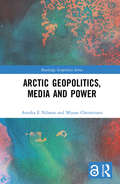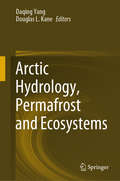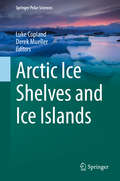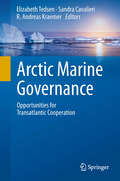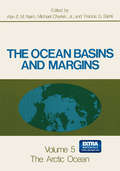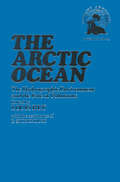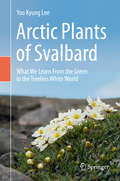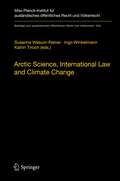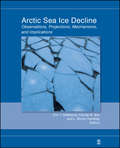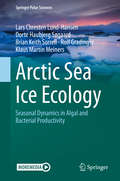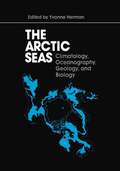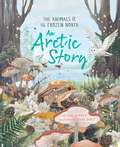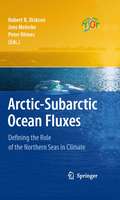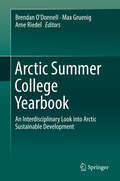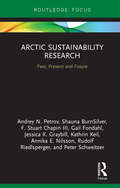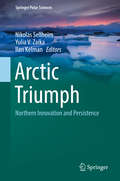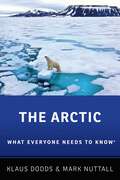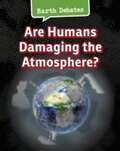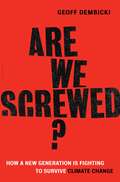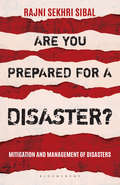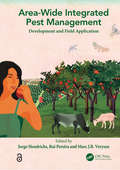- Table View
- List View
Arctic Geopolitics, Media and Power (Routledge Geopolitics Series)
by Annika Nilsson E. Miyase ChristensenArctic Geopolitics, Media and Power provides a fresh way of looking at the potential and limitations of regional international governance in the Arctic region. Far-reaching impacts of climate change, its wealth of resources and potential for new commercial activities have placed the Arctic region into the political limelight. In an era of rapid environmental change, the Arctic provides a complex and challenging case of geopolitical interplay. Based on analyses of how actors from within and outside the Arctic region assert their interests and how such discourses travel in the media, this book scrutinizes the social and material contexts within which new imaginaries, spatial constructs and scalar preferences emerge. It places ground-breaking attention to shifting media landscapes as a critical component of the social, environmental and technological change. It also reflects on the fundamental dilemmas inherent in democratic decision making at a time when an urgent need for addressing climate change is challenged by conflicting interests and growing geopolitical tensions. This book will be of great interest to geography academics, media and communication studies and students focusing on policy, climate change and geopolitics, as well as policy-makers and NGOs working within the environmental sector or with the Arctic region. The Open Access version of this book, available at http://www.tandfebooks.com/doi/view/10.4324/9780367189822 has been made available under a Creative Commons Attribution-Non Commercial-No Derivatives 4.0 license.
Arctic Hydrology, Permafrost and Ecosystems
by Daqing Yang Douglas L. KaneThis book provides a comprehensive, up-to-date assessment of the key terrestrial components of the Arctic system, i.e., its hydrology, permafrost, and ecology, drawing on the latest research results from across the circumpolar regions. The Arctic is an integrated system, the elements of which are closely linked by the atmosphere, ocean, and land. Using an integrated system approach, the book’s 30 chapters, written by a diverse team of leading scholars, carefully examine Arctic climate variability/change, large river hydrology, lakes and wetlands, snow cover and ice processes, permafrost characteristics, vegetation/landscape changes, and the future trajectory of Arctic system evolution. The discussions cover the fundamental features of and processes in the Arctic system, with a special focus on critical knowledge gaps, i.e., the interactions and feedbacks between water, permafrost, and ecosystem, such as snow pack and permafrost changes and their impacts on basin hydrology and ecology, river flow, geochemistry, and energy fluxes to the Arctic Ocean, and the structure and function of the Arctic ecosystem in response to past/future changes in climate, hydrology, and permafrost conditions. Given its scope, the book offers a valuable resource for researchers, graduate students, environmentalists, managers, and administrators who are concerned with the northern environment and resources.
Arctic Ice Shelves and Ice Islands (Springer Polar Sciences)
by Luke Copland Derek MuellerThis book provides an overview of the current state of knowledge of Arctic ice shelves, ice islands and related features. Ice shelves are permanent areas of ice which float on the ocean surface while attached to the coast, and typically occur in very cold environments where perennial sea ice builds up to great thickness, and/or where glaciers flow off the land and are preserved on the ocean surface. These landscape features are relatively poorly studied in the Arctic, yet they are potentially highly sensitive indicators of climate change because they respond to changes in atmospheric, oceanic and glaciological conditions. Recent fracturing and breakup events of ice shelves in the Canadian High Arctic have attracted significant scientific and public attention, and produced large ice islands which may pose a risk to Arctic shipping and offshore infrastructure. Much has been published about Antarctic ice shelves, but to date there has not been a dedicated book about Arctic ice shelves or ice islands. This book fills that gap.
Arctic Marine Governance: Opportunities for Transatlantic Cooperation
by Elizabeth Tedsen Sandra Cavalieri R. Andreas KraemerThe Arctic region plays an important role in regulating the world’s climate and is also highly impacted by climate change, with average temperatures rising almost twice as fast as the rest of the world and sea ice melting much faster than previously predicted. These rapid changes will have significant impacts on human activity in the region and on the Arctic marine environment. This book draws on the results of the 2008-2009 Arctic TRANSFORM project, funded by the European Commission‘s Directorate General of External Relations, which engaged experts in a transatlantic discussion on the roles of the European Union and United States in light of the Arctic’s changing climate and political and legal complexities. . The book addresses the significant changes and developments in the marine Arctic, with descriptions and recommendations reflecting the current governance environment. A comprehensive overview of environmental governance and sustainable development in the Arctic is created. Chapters explore impacts and activities by sector, looking at fisheries, shipping, and offshore hydrocarbon in the Arctic, and at policy options and strategies for improving marine governance in the region. A particular focus is given to the roles of the European Union and United States and opportunities for cooperation to enhance Arctic environmental governance. .
The Arctic Ocean
by Alan NairnThis trip backward in time capsulizes in a general way the geologic development of the area that is now northern Alaska. The Cretaceous through Recent history is predominantly one of erosion of the ancient Brooks Range and filling of the Colville Geosyncline under processes like those in Operation today. All the rocks older than Jurassic, however, were deposited far from their present sites. One of the intriguing tectonic puzzles involves the geographic positions and relative timing of events that occurred during the orogeny that built the Brooks Range. I suggest that pre-Cretaceous deposition took place far to the north along the western margin of the Caledonides. Subsequently, the region that is now northern Alaska moved southward and impinged upon a northward moving plate, or plates, from the Pacific region. Interactions between these two major parts of the earth's crust produced the Brooks Range during the Jurassic. Later developments reflect continuing readjustments of the northern third of of thrust Alaska as southward movement was dissipated in diverse systems faulting and lateral displacement. ACKNOWLEDGMENTS I am indebted to many colleagues who, during the past 30 years, shared with me the excitement and pleasures of exploring the geology of northern Alaska. Among these are W. P. Brosge, H. N. Reiser, R. L. Detterman, A. K. Armstrong, A. L. Bowsher, E. G. Sable, I. L. Tailleur, C. G. Mull, M. D. Mangus, A. H. Lachenbruch, M. C. Lachenbruch, R. L. Morris, C. J.
Arctic Plants of Svalbard: What We Learn From the Green in the Treeless White World
by Yoo Kyung LeeThe Arctic is a special world. The Arctic Ocean is covered by white sea ice, and its margins are surrounded by bare terrestrial regions, known as tundra. Tundra is a cold and dry environment without trees, but even in the absence of trees, tundra plants such as dwarf shrubs, grasses, herbs and moss support the harsh environment by providing sustenance and shelter. This book introduces representative arctic plants and their function in Svalbard, revealing the unique tundra ecosystem, and discussing the direct and indirect effects of climate change in the Arctic.
Arctic Science, International Law and Climate Change: Legal Aspects of Marine Science in the Arctic Ocean (Beiträge zum ausländischen öffentlichen Recht und Völkerrecht #235)
by Susanne Wasum-Rainer Ingo Winkelmann Katrin TirochDevelopments in the Arctic region are increasingly part of international discussion. The book contains a comprehensive and interdisciplinary analysis of the current problems around marine scientific research in the Arctic region. It combines scientific, legal and policy aspects. The main questions addressed are: ongoing and future Arctic marine research, marine research in the Arctic Ocean in practice, the legal framework, enlarged continental shelves and the freedom of marine science and particularities and challenges of the Arctic region. The contributors are leading experts in the field of politics, law and science.
Arctic Sea Ice Decline: Observations, Projections, Mechanisms, and Implications (Geophysical Monograph Series #180)
by Eric T. DeWeaver Cecilia M. Bitz L. Bruno TremblayPublished by the American Geophysical Union as part of the Geophysical Monograph Series, Volume 180.This volume addresses the rapid decline of Arctic sea ice, placing recent sea ice decline in the context of past observations, climate model simulations and projections, and simple models of the climate sensitivity of sea ice. Highlights of the work presented here include An appraisal of the role played by wind forcing in driving the decline; A reconstruction of Arctic sea ice conditions prior to human observations, based on proxy data from sediments; A modeling approach for assessing the impact of sea ice decline on polar bears, used as input to the U.S. Fish and Wildlife Service's decision to list the polar bear as a threatened species under the Endangered Species Act; Contrasting studies on the existence of a "tipping point," beyond which Arctic sea ice decline will become (or has already become) irreversible, including an examination of the role of the small ice cap instability in global warming simulations; A significant summertime atmospheric response to sea ice reduction in an atmospheric general circulation model, suggesting a positive feedback and the potential for short-term climate prediction. The book will be of interest to researchers attempting to understand the recent behavior of Arctic sea ice, model projections of future sea ice loss, and the consequences of sea ice loss for the natural and human systems of the Arctic.
Arctic Sea Ice Decline: Observations, Projections, Mechanisms, and Implications (Geophysical Monograph Series #180)
by Eric T. DeWeaver Cecilia M. Bitz L. Bruno TremblayPublished by the American Geophysical Union as part of the Geophysical Monograph Series, Volume 180.This volume addresses the rapid decline of Arctic sea ice, placing recent sea ice decline in the context of past observations, climate model simulations and projections, and simple models of the climate sensitivity of sea ice. Highlights of the work presented here include An appraisal of the role played by wind forcing in driving the decline; A reconstruction of Arctic sea ice conditions prior to human observations, based on proxy data from sediments; A modeling approach for assessing the impact of sea ice decline on polar bears, used as input to the U.S. Fish and Wildlife Service's decision to list the polar bear as a threatened species under the Endangered Species Act; Contrasting studies on the existence of a "tipping point," beyond which Arctic sea ice decline will become (or has already become) irreversible, including an examination of the role of the small ice cap instability in global warming simulations; A significant summertime atmospheric response to sea ice reduction in an atmospheric general circulation model, suggesting a positive feedback and the potential for short-term climate prediction. The book will be of interest to researchers attempting to understand the recent behavior of Arctic sea ice, model projections of future sea ice loss, and the consequences of sea ice loss for the natural and human systems of the Arctic.
Arctic Sea Ice Ecology: Seasonal Dynamics in Algal and Bacterial Productivity (Springer Polar Sciences)
by Lars Chresten Lund-Hansen Dorte Haubjerg Søgaard Brian Keith Sorrell Rolf Gradinger Klaus Martin MeinersThe book on sea ice ecology is the ecology of sea ice algae and other microorganism as bacteria, meiofauna, and viruses residing inside or at the bottom of the sea ice, called the sympagic biota. Organisms as seals, fish, birds, and Polar bears relies on sea ice but are not part of this biota. A distinct feature of this ecosystem, is the disappearance (melt) every summer and re-establishing in autumn and winter. The book is organized seasonally describing the physical, optical, biological, and geochemical conditions typical of the seasons: autumn, winter, and spring. These are exemplified with case studies based on author’s fieldwork in Greenland, the Arctic Ocean, and Antarctica but focused on Arctic conditions. The sea ice ecosystem is described in the context of climate change, interests, and effects of a decreasing summer ice extent in the Arctic Ocean. The book contains an up to date description of most relevant methods and techniques applied in sea ice ecology research.This book will appeal to university students at Masters or PhD levels reading biology, geosciences, and chemistry.
The Arctic Seas: Climatology, Oceanography, Geology, and Biology
by Yvonne HermanThe Arctic region has long held a fascination for explorers and scientists of many countries. Despite the numerous voyages of exploration, the na ture of the central Arctic was unknown only 90 years ago; it was believed to be a shallow sea dotted with islands. During Nansen's historic voyage on the polarship Fram, which commenced in 1893, the great depth of the central basin was discovered. In the Soviet Union, investigation of the Arctic Ocean became national policy after 1917. Today research at several scientific institutions there is devoted primarily to the study of the North Polar Ocean and seas. The systematic exploration of the Arctic by the United States com menced in 1951. Research has been conducted year-round from drifting ice islands, which are tabular fragments of glacier ice that break away from ice shelves. Most frequently, ice islands originate off the northern coast of Ellesmere Island. These research platforms are occupied as weather sta tions, as well as for oceanographic and geophysical studies. Several inter national projects, conducted by Canadian, European, and U. S. groups, have been underway during the last three decades. Although much new data have accumulated since the publication of the Marine Geology and Oceanography of the Arctic Seas volume in 1974 (Yvonne Herman, ed. ), in various fields of polar research-including present-day ice cover, hydrogra phy, fauna, flora, and geology-many questions remain to be answered.
An Arctic Story: An Arctic Story
by Jane BurnardThis lovely book brings together facts about the Arctic, a poetic, evocative narrative, and breath-taking illustrations. The story begins at the outer edge of the Arctic Circle, where the extraordinary wood frog is beginning to freeze, and then works its way inwards to the north pole – through the tundra then into the sea and ice at the very centre. Then the scenes work their way back outwards. As the book progresses, winter progresses. By the end we are back to the taiga, back to spring after the long winter, and back to the wood frog, who is defrosting now.
Arctic-Subarctic Ocean Fluxes: Defining the Role of the Northern Seas in Climate
by Robert R. Dickson Jens Meincke Peter RhinesWe are only now beginning to understand the climatic impact of the remarkable events that are now occurring in subarctic waters. Researchers, however, have yet to agree upon a predictive model that links change in our northern seas to climate. This volume brings together the body of evidence needed to develop climate models that quantify the ocean exchanges through subarctic seas, measure their variability, and gauge their impact on climate.
Arctic Summer College Yearbook: An Interdisciplinary Look into Arctic Sustainable Development
by Brendan O'Donnell Max Gruenig Arne RiedelThis book highlights both the diversity of perspectives and approaches to Arctic research and the inherent interdisciplinary nature of studying and understanding this incomparable region. The chapters are divided into four liberally-defined sections to provide space for dynamic interpretation and dialogue in search of sustainable solutions to the issues facing the Arctic. From governance to technology, scientific research to social systems, human health to economic development, the authors discuss fundamental questions while looking toward the Arctic’s future. Whether the reader is well-versed in the history and complexity of Arctic policy or looking for an insightful introduction to the vast world of Arctic research, everyone will find answers that lead to new questions and even more discoveries in these pages, laying the foundation for tomorrow’s discussion on the future of the Arctic. The Arctic’s unique geographic and political characteristics pose questions for the international community, indigenous peoples, and economic interests not easily answered through traditional concepts. To that end, the Arctic Summer College has been engaging leading professionals, students, scholars, and policy makers from across the globe to exchange ideas and support further investigation into the Arctic. A joint venture between Ecologic Institute US and Ecologic Institute Berlin (Germany), the College participates at the annual Arctic Circle Assembly in Reykjavik, Iceland, and continues to be at the forefront of international collaboration in this critical area of economic, political, environmental, and humanitarian development.
Arctic Sustainability Research: Past, Present and Future (Routledge Research in Polar Regions)
by Andrey N. Petrov Shauna BurnSilver F. Stuart Chapin III Gail Fondahl Jessica K. Graybill Kathrin Keil Annika E. Nilsson Rudolf Riedlsperger Peter SchweitzerThe Arctic is one of the world’s regions most affected by cultural, socio-economic, environmental, and climatic changes. Over the last two decades, scholars, policymakers, extractive industries, governments, intergovernmental forums, and non-governmental organizations have turned their attention to the Arctic, its peoples, resources, and to the challenges and benefits of impending transformations. Arctic sustainability is an issue of increasing concern as well as the resilience and adaptation of Arctic societies to changing conditions. This book offers key insights into the history, current state of knowledge and the future of sustainability, and sustainable development research in the Arctic. Written by an international, interdisciplinary team of experts, it presents a comprehensive progress report on Arctic sustainability research. It identifies key knowledge gaps and provides salient recommendations for prioritizing research in the next decade. Arctic Sustainability Research will appeal to researchers, academics, and policymakers interested in sustainability science and the practices of sustainable development, as well as those working in polar studies, climate change, political geography, and the history of science.
Arctic Sustainability Research: Past, Present and Future (Routledge Research in Polar Regions)
by Andrey N. Petrov Shauna BurnSilver F. Stuart Chapin III Gail Fondahl Jessica K. Graybill Kathrin Keil Annika E. Nilsson Rudolf Riedlsperger Peter SchweitzerThe Arctic is one of the world’s regions most affected by cultural, socio-economic, environmental, and climatic changes. Over the last two decades, scholars, policymakers, extractive industries, governments, intergovernmental forums, and non-governmental organizations have turned their attention to the Arctic, its peoples, resources, and to the challenges and benefits of impending transformations. Arctic sustainability is an issue of increasing concern as well as the resilience and adaptation of Arctic societies to changing conditions. This book offers key insights into the history, current state of knowledge and the future of sustainability, and sustainable development research in the Arctic. Written by an international, interdisciplinary team of experts, it presents a comprehensive progress report on Arctic sustainability research. It identifies key knowledge gaps and provides salient recommendations for prioritizing research in the next decade. Arctic Sustainability Research will appeal to researchers, academics, and policymakers interested in sustainability science and the practices of sustainable development, as well as those working in polar studies, climate change, political geography, and the history of science.
Arctic Triumph: Northern Innovation and Persistence (Springer Polar Sciences)
by Nikolas Sellheim Yulia V. Zaika Ilan KelmanThis book approaches the challenges the Arctic has faced and is facing through a lens of opportunity. Through pinpointed examples from and dealing with the Circumpolar North, the Arctic is depicted as a region where people and peoples have managed to endure despite significant challenges at hand. This book treats the ‘Arctic of disasters’ as an innovated narrative and asks how the ‘disaster pieces’ of Arctic discourse interact with the ability of Arctic peoples, communities and regions to counter disaster, adversity, and doom. While not neglecting the scientifically established challenges associated with climate change and other (potentially) disastrous processes in the north, this book calls for a paradigm shift from perceiving the ‘Arctic of disasters’ to an ‘Arctic of triumph’. Particular attention is therefore given to selected Arctic achievements that underline ‘triumphant’ developments in the north, even when Arctic triumph and disaster intersect.
Arctic Underwater Operations: Medical and Operational Aspects of Diving Activities in Arctic Conditions
by LouisReyOpening Speech of the ICEDIVE 84 Conference by His Royal Highness Prince Bertil of Sweden I am very pleased to be invited to open the International Conference ICEDIVE 84, dealing with medical and technical problems of diving and related underwater activities in arctic conditions. Until recent times, the arctic was considered astrange and remote area of minor importance. However, in a world with diminishing natural resources, arctic areas have become a region of global importance because of their enormous resources and strategie position. Certain experts believe that more than 50% of oil reserves are "sleeping" in these northern areas which are cold, harsh and hostile to man. Operations in arctic areas are extremely difficult, expensive, and demand high levels of technical, scientific and physiological achievement. One should recall for example, that Alaskan oil investment onIy became economically viable after the 1973-1974 price explosion. Recent political/military troubles in the Gulf have increased interest in the development of polar resources. This conference is unique as it is the first time that medical and technical specialists interested in the problem of diving in arctic conditions have met in an international forum. Development of the arctic resources is a matter of international urgency, and it pleases me that scientists from the USA, Canada, the USSR, Australia and Europe have gathered here in Stockholm to present their experience and to discuss problems in this field.
ARCTIC WENK C: What Everyone Needs to Know® (What Everyone Needs To Know®)
by Klaus Dodds Mark NuttallConversations defining the Arctic region often provoke debate and controversy -- for scientists, this lies in the imprecise and imaginary line known as the Arctic Circle; for countries like Canada, Russia, the United States, and Denmark, such discussions are based in competition for land and resources; for indigenous communities, those discussions are also rooted in issues of rights. These shifting lines are only made murkier by the threat of global climate change. In the Arctic Ocean, the consequences of Earth's warming trend are most immediately observable in the multi-year and perennial ice that has begun to melt, which threatens ice-dependent microorganisms and, eventually, will disrupt all of Arctic life and raise sea levels globally. In The Arctic: What Everyone Needs to Know®, Klaus Dodds and Mark Nuttall offer concise answers to the myriad questions that arise when looking at the circumpolar North. They focus on its peoples, politics, environment, resource development, and conservation to provide critical information about how changes there can, and will, affect our entire globe and all of its inhabitants. Dodds and Nuttall explore how the Arctic's importance has grown over time, the region's role during the Cold War, indigenous communities and their history, and the past and future of the Arctic's governance, among other crucial topics.
Are Humans Damaging the Atmosphere? (Earth Debates)
by Catherine ChambersCar, train, ship or aeroplane – which form of transport is most harmful to the atmosphere? What do farming techniques such as agrochemicals do? What is ‘acid rain’ and what are effects of it? This book takes a look at the impact that our modern world is having on our surrounding environment, from our use of fossil fuels and our increase in global food production and building work, to the rise in our transport production. Discover what steps scientists and engineers, and even ordinary people, are taking to develop sustainable solutions to these problems, from replastering festivals to buildings bound together using horse hair!
Are We Screwed?: How a New Generation is Fighting to Survive Climate Change
by Geoff DembickiA declaration of resistance, and a roadmap for radical change, from the generation that will be most screwed by climate change. The Millennial generation could be first to experience the doomsday impacts of climate change. It's also the last generation able to do something about them. With time ticking down, 31-year-old journalist Geoff Dembicki journeyed to Silicon Valley, Canada's tar sands, Washington, DC, Wall Street and the Paris climate talks to find out if he should hope or despair. What he learned surprised him. Millions of people his age want to radically change our world, and they are at the forefront of resistance to the politicians and CEOs steering our planet towards disaster. In Are We Screwed?, Dembicki gives a firsthand account of this movement, and the shift in generational values behind it, through the stories of young people fighting for their survival. It begins with a student who abandons society to live in the rainforest and ends with a Muslim feminist fomenting a political revolution. We meet a Brooklyn artist terrifying the oil industry, a Norwegian scientist running across the melting Arctic and an indigenous filmmaker challenging the worldview of Mark Zuckerberg. Are We Screwed? makes a bold argument in these troubled times: A safer and more equitable future is more achievable than we've been led to believe. This book will forever change how you view the biggest existential challenge of our era and redefine the generation now battling against the odds to solve it.
Are You Prepared for a Disaster?: Mitigation and Management of Disasters
by Rajni Sekhri SibalWe live in a world which experiences dramatic loss of life due to natural disasters and hazards.This comprehensive book by Rajni Sibal, formerly the additional secretary (disaster management), Government of India, outlines methods for preparing households, businesses, and commercial establishments to address the substantial risk of disasters at home, the workplace and communities at large.Rajni Sibal addresses considerations important in planning for disaster management, from cyclones, chemical spills, floods and landslides to catastrophic events. The book not only includes the procedures used by safety experts but also focuses on areas often overlooked during the reactive and post disaster periods.Packed with information, important contact details and numbers, this book contains a extensive list of the how-to's for avoiding mistakes which turn natural and man-made catastrophes into larger disasters, and makes preparing for disaster less intimidating.
Area-wide Integrated Pest Management: Development and Field Application
by Jorge Hendrichs Rui Pereira Marc J. B. VreysenOver 98% of sprayed insecticides and 95% of herbicides reach a destination other than their target species, including non-target species, air, water and soil. The extensive reliance on insecticide use reduces biodiversity, contributes to pollinator decline, destroys habitat, and threatens endangered species. This book offers a more effective application of the Integrated Pest Management (IPM) approach, on an area-wide (AW) or population-wide (AW-IPM) basis, which aims at the management of the total population of a pest, involving a coordinated effort over often larger areas. For major livestock pests, vectors of human diseases and pests of high-value crops with low pest tolerance, there are compelling economic reasons for participating in AW-IPM. This new textbook attempts to address various fundamental components of AW-IPM, e.g. the importance of relevant problem-solving research, the need for planning and essential baseline data collection, the significance of integrating adequate tools for appropriate control strategies, and the value of pilot trials, etc. With chapters authored by 184 experts from more than 31 countries, the book includes many technical advances in the areas of genetics, molecular biology, microbiology, resistance management, and social sciences that facilitate the planning and implementing of area-wide strategies. The book is essential reading for the academic and applied research community as well as national and regional government plant and human/animal health authorities with responsibility for protecting plant and human/animal health.
Area-wide Integrated Pest Management: Development and Field Application
by Jorge Hendrichs; Rui Pereira; Marc J.B. VreysenOver 98% of sprayed insecticides and 95% of herbicides reach a destination other than their target species, including non-target species, air, water and soil. The extensive reliance on insecticide use reduces biodiversity, contributes to pollinator decline, destroys habitat, and threatens endangered species. This book offers a more effective application of the Integrated Pest Management (IPM) approach, on an area-wide (AW) or population-wide (AW-IPM) basis, which aims at the management of the total population of a pest, involving a coordinated effort over often larger areas. For major livestock pests, vectors of human diseases and pests of high-value crops with low pest tolerance, there are compelling economic reasons for participating in AW-IPM. This new textbook attempts to address various fundamental components of AW-IPM, e.g. the importance of relevant problem-solving research, the need for planning and essential baseline data collection, the significance of integrating adequate tools for appropriate control strategies, and the value of pilot trials, etc. With chapters authored by 184 experts from more than 31 countries, the book includes many technical advances in the areas of genetics, molecular biology, microbiology, resistance management, and social sciences that facilitate the planning and implementing of area-wide strategies. The book is essential reading for the academic and applied research community as well as national and regional government plant and human/animal health authorities with responsibility for protecting plant and human/animal health.
